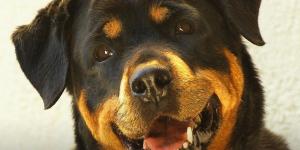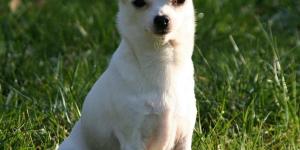Rottweiler

The Rottweiler is a strong, robust and athletic dog. This is a medium to large size breed with an an incredibly powerful appearance. Rottweilers are hugely admired by many and also carry a mythical-like fear for those who are not familiar with it.
The mere presence of these dogs command respect and it is easy to be scared of such a powerful-looking animal.
However, those who have had the opportunity to become familiar with Rottweilers know that behind that strong and occasionally terrifying appearance, a properly socialized Rottweiler can carry the heart of an angel and devotion of a saint.
In this AnimalWised breed card at we will review all the history, health and characteristics of a Rottweiler and the specific care it needs.
- Europe
- Germany
- Group II
- 5-14
- 14-18
- 18-22
- 22-27
- 27-31
- More than 31
- 2-7
- 7-22
- 22-55
- 55-100
- 100-220
- 8-10
- 10-12
- 12-14
- 15-20
- Low
- Meidum
- High
History of a Rottweiler
This breed originates from the German region of Rottweil. However, its history dates back to Roman times. At that time, the predecessors of the current Rottweiler were employed as guard dogs and/or to drive cattle.
When the Romans arrived in the Rottweil region, their dogs mated with local dogs. The result of these crosses gave rise to the "Rottweil butcher dog", which was used to help the local butchers during cattle slaughter. These dogs were in charge of controlling the most aggressive bulls and cows, facilitating the activity of the butchers. Due to their bravery, they were also used to protect properties. With the passing of time, the capacity of the breed was recognized for other functions and its popularity began to emerge.
Currently the Rottweiler is stigmatized and has been designated as a dangerous dog, because of irresponsible and unscrupulous owners. Many hope that this will not harm the breed or bring it to the brink of extinction.
Physical characteristics of a Rottweiler
Perhaps the most notorious characteristic of the Rottweiler is its head of broad and of medium length, which has a powerful snout that is neither short nor long. Its bite achieves all its power thanks to its strong and wide jaw.
Its eyes, medium-sized and dark brown, give the dog an expression of confidence. In contrast, the triangular and hanging ears of the Rottweiler are not particularly striking and are easily ignored by the common observer. However, being well attached to the head and facing forward, they give the skull a broader appearance.
The body of the Rottweiler is powerful and robust, but can be susceptible to becoming coarse or fat (if not maintained). This is an athletic and agile dog, capable of overcoming the most difficult work tests. Its strong and straight back continues onto a short, strong and deep maine. Its chest, on the other hand, is wide and deep and has a well-developed parapet. Thanks to its robust body, the Rottweiler is capable of knocking down an adult without a bite.
Previously, it was required to amputate the tail of these dogs for "aesthetic" purposes. Today, and fortunately for dogs, the standard of the International Cynological Federation (FCI) requires that full tails remain. Unfortunately, other organizations continue to accept amputated tails in their regulations..
When talking about the appearance of the Rottweiler one cannot fail to mention this dog’s hard double coat of average length. The black and tan color of their mantle helps define the Rottweiler’s image.
Its height at the withers is 61 to 68 centimeters for males, and 56 to 63 centimeters for females. Its approximate weight is 50 kilograms in males, and 42 kilograms in females.
Character of a Rottweiler
This breed is known to be: attentive, obedient, calm, courageous, confident, trustworthy and loyal to their owners. Of course, we must bear in mind that not all "rotties" have this common character, as all dogs are instinctively different.
Rottweilers have stood out in the past, and continue to do so today, as one of the most versatile and intelligent breeds. Their flexibility and emotional stability allow them to adapt well to different activities, so they can be trained to be protective and obedient. These dogs are also often trained to be police dogs, therapy dogs and assistance dogs. They can also be trained as search and rescue dogs.
In addition to these mentioned activities, the rottweiler normally obtains very good results in dog sports and obedience competitions. But the character of the rottweiler also has its disadvantages. Despite being very self-confident, "rotties" can be very reactive. Therefore, it is very important to socialize these dogs from when they are puppies. This socialization is mandatory to ensure that they get along with people, dogs and other animals. Training in basic obedience is a must with a dog of these characteristics.
This breed is one of those that has fallen into the category of "potentially dangerous dogs" in many countries. This is a pity since the Rottweiler is only a dangerous dog when educated by irresponsible people who foment its aggressiveness. The character of a correctly socialized Rottweiler is far from dangerous and, on the contrary, it is a docile and friendly dog. It all depends on how the dog is educated.
Taking care of a Rottweiler
The Rottweiler is easy to care for. Its coat is very easy to maintain. It should be bathed every 2 or 3 months and brushed once a week at least, to eliminate dead hair remains. The rest of its body areas such as teeth, nails or ears should also be cleaned weekly.
On the other hand, the Rottweiler is a dog that has a tendency to get fat, so time spent preventing obesity in necessary. This breed needs to be given adequate doses of food, exercise and moderate snacks. An overweight dog becomes prone to degenerative diseases such as hip dysplasia or osteoarthritis, therefore this needs to be consciously avoided.
Exercise will be one of the pillars of Rottweiler care. We are speaking about a breed of dog that love to exercise and practice all kinds of activities. Its intelligence also allows the working of more complex activities such as dog agility training. It is very important to correctly meet this dog’s needs to prevent it from suffering from problems such as anxiety or stress.
Educating a Rottweiler
The rottweiler is an intelligent and skillful companion with imposing physical characteristics . For that reason, training is very important for this breed. A dog with such qualities cannot suffer from deficiencies in their education because it could affect their adult life negatively.
To begin with, in educating a puppy Rottweiler, you must focus mainly on socialization: the process in which we present the Rottweiler dog to other dogs, pets, people and objects. This is an extremely important part of training a Rottweiler because without correct socialization it can result in a reactive, fearful and insecure dog. Developing good socialization will allow you and your dog to be with all kinds of people and in all kinds of environments without any problems. It is also important to enrich and mentally stimulate your puppy during its younger years.
It is also very important to remember that a training of a Rottweiler never ends, this dog needs to be constantly stimulated and reminded of rules. These dogs also respond best to positive reinforcement.
Health of a Rottweiler
Rottweilers are usually a relatively healthy dogs, with a life expectancy of about 10 years. The most common diseases in this breed are usually hip dysplasia or cancer, although by regularly visiting the veterinarian this can be avoided.
It is always important to follow the deworming and vaccine schedule strictly to avoid any possible viral, bacterial or parasitic infections in this breed.
Rottweiler photos




















